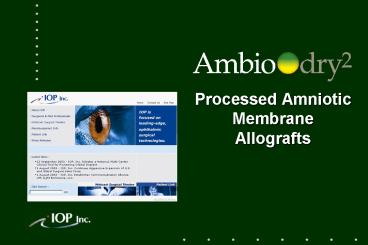Processed Amniotic Membrane Allografts - PowerPoint PPT Presentation
1 / 26
Title:
Processed Amniotic Membrane Allografts
Description:
Title: Gold Eyelid Weight Implants Author: IOP Last modified by: Erich Ziegler Created Date: 8/1/2000 7:08:39 PM Document presentation format: 35mm Slides – PowerPoint PPT presentation
Number of Views:181
Avg rating:3.0/5.0
Title: Processed Amniotic Membrane Allografts
1
- Processed Amniotic Membrane Allografts
2
Amniotic Membrane Allografts
3
(No Transcript)
4
(No Transcript)
5
(No Transcript)
6
(No Transcript)
7
What is Human Amniotic Membrane?
- A unique, avascular membrane separating the
mother from the fetus. - Provides an incubating environment promoting
cellular differentiation. - Provides an immunological barrier to prevent
foreign body rejection.
Photo Courtesy of Juan Batlle, M.D.
8
Anatomical Profile AM
9
Anatomy of the Ocular Surface
(1) Conjunctival Epithelium (2) Corneal
Epithelium (6) Limbus Stem Cells
10
History of AM in Ophthalmology
- De Rotth. conjunctival defects (1940).
- Lavery. lime burn of conjunctiva and cornea
(1946). - Sorsby et al. caustic soda burns (1947).
- ALLOTRANSPLANTAT late 80s USSR-gtVenezuela, DR
- Batlle and Perdomo. Conjunctival substitute with
placental allotransplant. Scientific Poster 25.
American Academy of Ophthalmology meeting.
Chicago, IL USA. October 1993. - Kim and Tseng. Transplantation of preserved human
amniotic membrane for surface reconstruction in
severely damaged rabbit corneas. Cornea
14473-84, 1995.
11
Surgical Indications AM
- Pterygium Excision
- Corneal Ulcerations/Perforations
- Chemical/Thermal Burns
- Bullous Keratopathy
- Ocular Dermoids/Tumors
- Fornix Reconstruction/Symblepharon
- Stem Cell Transplants
12
Pterygium
- A mutated growth on the surface of the eye
- Requires surgical excision and placement of graft
13
Corneal Ulcerations/Perforations
- A break or defect in corneal epithelium
- Often secondary to other systemic diseases.
14
Chemical/Thermal Burns
- Chemical burns often caused by alkali
- Potentially devastating trauma to surface of the
eye - Limbal graft possibly indicated
15
Bullous Keratopathy
- Edema of the corneal endothelium
- Very common and usually affects individuals over
50 years of age.
16
Dermoid/Tumor Removal
- Benign congenital tumors containing foreign
tissue - Commonly found at the limbus
17
Fornix Reconstruction
- Fibrous tract that connects bulbar conj to conj
of eyelid - Secondary to other acquired or traumatic
conditions - Required reconstruction of ocular surface and
eyelids
18
Surgical Techniques AMT/Pterygium
Photo Courtesy of Juan Batlle, M.D.
19
AmbioDry2 Overview
- Tested Safe
- Dehydrated
- Terminally Sterilized
- Strict, quality-controlled protocols
- Device-like quality
20
AmbioDry Safe Viable
- Intact epithelial cell layer
- Intact dense connective, basement membrane
- Presence of loose fibroblast network
21
AmbioDry Logistical Features
- Storage Room-temp
- No freezer required
- No dry ice shipments
- Simple prep No soaks or rinses
- IOP Customer Service 24 Hrs/7 Days
22
AmbioDry Surgical Advantages
- Substrate-free
- Dry-state handling trimming
- Visual orientation identification
- No tears or buttonholes
- Device-like tissue quality
23
AmbioDry Configurations
- 1 x 2 cm
- 2 x 3 cm
- 4 x 4 cm
24
Reimbursement Codes
- Supply Code V2790
- CPT Code 65780 Ocular surface reconstruction
amniotic membrane transplantation
25
AmbioDry Tisseel
- The sutureless approach to eye surgery.
- Fibrin (biological) adhesive
- Eliminates sutures
- Reduces surgical time
- Improved patient care
- Better healing
26
AmbioDry Tisseel Video































